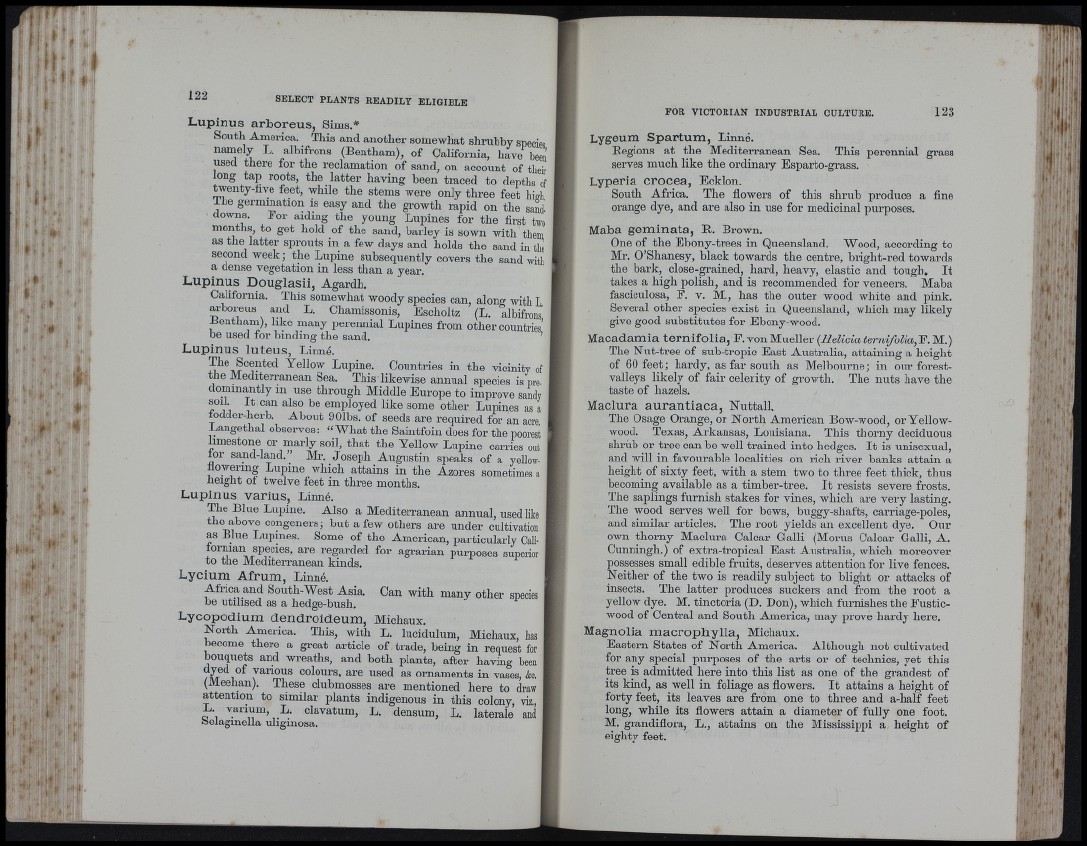
I 1i1
H ' . A
i
i I''
r
»
122 SELECT PLANTS READILY ELIGIBLE
Lupinus arboreus, Sims*
South America. This and another somewhat shrubby soecip«!
namely L. albifrons (Bentham), of California, have beeii
used there for the reclamation of sand, on account of tliefi
long tap roots, the latter having been traced to depths of
twenty-five feet, while the stems were only three feet high
Ih e germination is easy and the growth rapid on the sand
downs. For aiding the young Lupines for the first fivo
months, to get hold of the sand, barley is sown with them
as the latter sprouts in a few days and holds the sand in th^
second week; the Lupine subsequently covers the sand with
a dense vegetation in less than a year.
Lupinus Douglasii, Agardh.
California. This somewhat woody species can, along with L
arborens and L. Chamissonis, Escholtz (L. albifrons',
Eentham), like many perennial Lupines from other countries
be used for binding the sand. ’
Lupinus luteus, Linné.
The Scented Yellow Lupine. Countries in the vicinity of
the Mediterranean Sea. This likewise annual species is predominantly
in use through Middle Europe to improve sandy
soil I t can also be employed like some other Lupines as a
fodder-herb. About 901bs. of seeds are required for an acre
Langethal observes : “What the Saintfoin does for the poorest
limestone or marly soil, that the Yellow Lupine carries out
tor sand-land.’’ Mr. Joseph Augustin speaks of a yellow-
fiowermg Lupine which attains in the Azores sometimes a
height of twelve feet in three months.
Lupinus varius, Linné.
The Blue Lupine. Also a Mediterranean annual, used like
the above congeners; but a few others are under cultivation
as Blue Lupines. Some of the American, particularly Cali-
iornian species, are regarded for agrarian purposes superior
to the Mediterranean kinds.
Lycium Afrum, Linné.
Africa and South-West Asia. Can with many other species
be utilised as a hedge-bush,
Lycopodium dendroideum, Michaux.
North America. This, with L. lucidulum, Michaux, has
become there a great article of trade, being in request foibouquets
and wreaths, and both plants, after having heen
various colours, are used as ornaments in vases, k.
(Meehan). These clubmosses are mentioned here to draw
attention to similar plants indigenous in this colony, viz.,
L varium, L. clavatum, L. densum, L. laterale and
Selagmella uligmosa.
FOR VICTORIAN INDUSTRIAL CULTURE. 123
Lygeum Spartum, Linné.
Begions at the Mediterranean Sea. This perennial grass
serves much like the ordinary Esparto-grass.
Lyperia crocea, Ecklon.
South Africa. The flowers of this shrub produce a fine
orange dye, and are also in use for medicinal purposes.
Maba geminata, B. Brown.
One of the Ebony-trees in Queensland. Wood, according to
Mr. O’Shanesy, black towards the centre, bright-red towards
the bark, close-gained, hard, heavy, elastic and tough. I t
takes a high polish, and is recommended for veneers. Maba
fasciculosa, E. v. M., has the outer wood white and pink.
Several other species exist in Queensland, which may likely
give good substitutes for Ebony-wood.
Macadamia ternifolia, F. von Mueller {Helicia t e r n i fo l ia ,M.)
The Nut-tree of sub-tropic East Australia, attaining a height
of 60 feet; hardy, as far south as Melbourne; in our forest-
valleys likely of fair celerity of growth. Tbe nuts have the
taste of hazels.
Madura aurantiaca, Nuttall.
The Osage Orange, or North American Bow-wood, or Yellow-
wood. Texas, Arkansas, Louisiana. This thorny deciduous
shriib or tree can be well trained into hedges. I t is unisexual,
and will in favourable localities on rich river banks attain a
height of sixty feet, with a stem two to three feet thick, thus
becoming available as a timber-tree. I t resists severe frosts.
The saplings furnish stakes for vines, which are very lasting.
The wood serves well for bows, buggy-shafts, carriage-poles,
and similar articles. The root yields an excellent dye. Our
own thorny Madura Calcar Galli (Morus Calcar Galli, A.
Cunningh.) of extra-tropical East Australia, which moreover
possesses small edible fruits, deserves attention for live fences.
Neither of the two is readily subject to blight or attacks of
insects. The latter produces suckers and from the root a
yellow dye. M. tinctoria (D. Don), which furnishes the Fustic-
wood of Central and South America, may prove hardy here.
Magnolia macrophylla, Michaux.
Eastern States of North America. Although not cultivated
for any special purposes of the arts or of technics, yet this
tree is admitted here into this list as one of the grandest of
its kind, as well in foliage as flowers. I t attains a height of
forty feet, its leaves are from one to three and a-half feet
long, while its flowers attain a diameter of fully one foot.
M. grandiflora, L., attains on the Mississippi a height of
eighty feet.
1 1 i* I
J |M
'H i : .
! HI''- ,
i
. i
I '
■Ik
m 1
'I;;
■ I f.I
■!
4 :
'b' , ; I-I”
' |ii i'V Ï;'